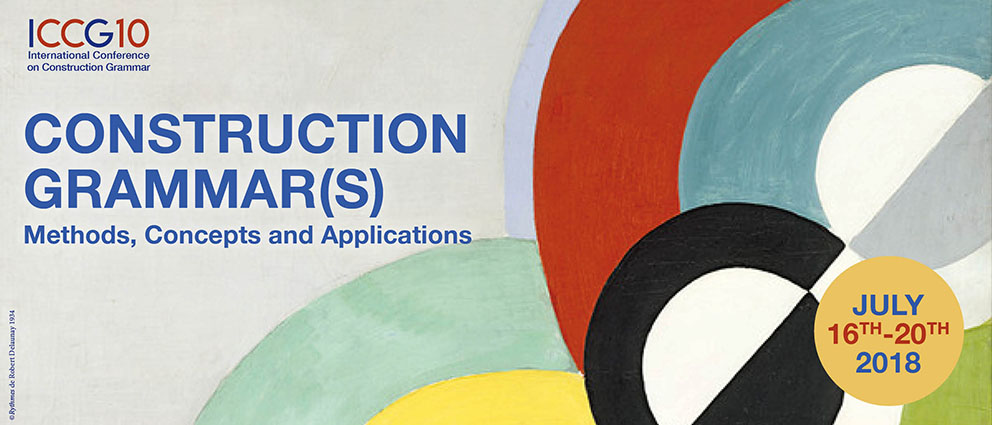 In der kommenden Woche findet in Paris die 10th International Conference on Construction Grammar (ICCG 10) statt (16. bis 18. Juli), bei der ich gemeinsam mit Hans Boas (The University of Texas at Austin) eine thematische Sektion zu Sprachkontakt und Konstruktionsgrammatik organsiere (Constructional Approaches to Language Contact and Multilingualism), mit Beiträgen zu ganz verschieden Sprachkontaktsituationen und Fragestellungen. Auch die Kieler Skandinavistik ist vertreten.
In der kommenden Woche findet in Paris die 10th International Conference on Construction Grammar (ICCG 10) statt (16. bis 18. Juli), bei der ich gemeinsam mit Hans Boas (The University of Texas at Austin) eine thematische Sektion zu Sprachkontakt und Konstruktionsgrammatik organsiere (Constructional Approaches to Language Contact and Multilingualism), mit Beiträgen zu ganz verschieden Sprachkontaktsituationen und Fragestellungen. Auch die Kieler Skandinavistik ist vertreten.
Beschreibung
Over the past decades, Construction Grammar (CxG) has gained a reputation for being able to integrate linguistic aspects that have traditionally been treated as lying on the fringe of the language system, far beyond the synchronic syntax-lexicon continuum that was the original focus of construction grammar, including, for example, diachronic change (Diewald 2007; Noël 2007; Bergs & Diewald 2008; Hilpert 2011, 2013; Barðdal et al. 2015), intralingual variation (Leino & Östman 2005), and first language acquisition (Tomasello 2005). In more recent years, this has included a slowly, but steadily increasing interest in language contact, and it has been argued that particularly usage-based approaches in CxG are better fitted to model multilingual phenomena than, for instance, most formalist grammatical theories.
This development has resulted in a small, but growing body of literature (e.g. the contributions in Hilpert & Östman 2016, Höder 2012, 2014ab, 2016, Wasserscheidt 2014, Ziegler 2015, Boas & Höder forthc.) as well as workshops in related fields, such as the workshop on Constructions across Grammars (Freiburg 2012), organised by Martin Hilpert and Jan-Ola Östman, and the workshop on Construction Grammar and Language Contact at the 8th International Conference on Construction Grammar (ICCG-8, Osnabrück 2014), organised by Hans Boas and Steffen Höder. Furthermore, CxG approaches to language contact have sparked interest among researchers working on second language acquisition as well (e.g. Hendrikx, van Goethem & Meunier 2015).
This special session brings together scholars approaching contact-related topics from a constructionist perspective in contributions that deal with various methodological, empirical, and theoretical aspects. The goal is to discuss how contact linguistics and CxG can benefit from each other, with particular emphasis on the following main questions:
(a) What are major challenges and advantages in using a constructionist framework in research on language contact?
(b) How can CxG approaches to language contact – in particular Diasystematic Construction Grammar (Höder 2012, 2014ab, forthc.) – be combined with various empirical methods, such as corpus analysis or experimental studies?
(c) What can CxG approaches to language contact contribute to related fields, such as second language acquisition or contrastive linguistics?
Programm
| Steffen Höder (Kiel) & Hans Boas (Austin) | Introduction |
| Steffen Höder (Kiel), Julia Prentice (Göteborg), Sofia Tingsell (Språkrådet, Stockholm) | Language contact, L2 acquisition and reorganization in the multilingual constructicon |
| Aileen Urban (Kiel) | Idioconstructions in conflict: Codeswitching as ad hoc generalization |
| Evelyn Wiesinger (Regensburg) | Romance-Germanic contact and constructions |
| Kristel Van Goethem & Isa Hendrikx (Université catholique de Louvain, Louvain-la-Neuve) | Intensifying constructions in the diasystem of Belgian French-speaking learners of Dutch and English |
| Bertus Van Rooy (North West University) | Constructional change and bidirectional contact: Complementiser omission in Afrikaans and South African English |
| Kevin Rottet (Indiana University, Bloomington) | Sitting, standing, and making one’s way: Language contact and constructional change in Welsh |
| Savithry Namboodiripad (University of Michigan) | Constructions in contact: Two studies of English-influenced language change |
| Ryan Dux (Institut für Deutsche Sprache, Mannheim) | Transfer of verbs and their constructional properties in German-American varieties |
| Christophe Béchet (Liège) | Mechanism of constructional borrowing in complex prepositions : the case of French and its closest Germanic prepositions |
| Conclusion |